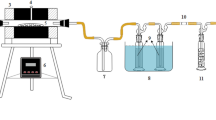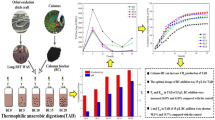Abstract
With the rapid development of urbanization, the number of urban sewage treatment plants is increasing, wastewater treatment volume is gradually becoming large, and correspondingly, the sludge production capacity has a rapid growth. As a new method of sludge disposal, sludge carbonization is characterized by low energy consumption, simple products, and wide resource utilization prospects, which is of great help to solve problems of current sludge disposal in China. The residual sludge from sewage plant was used as raw material in this study in order to investigate the physical and chemical properties of sludge charcoal after high temperature carbonization and explore the enhancement in the removal of pollutants including CODcr, NH3-N, TN, and TP during sewage treatment with the used sludge charcoal. The results show that the optimal dosing amount of sludge charcoal was 2 g.L−1 when it was added into SBR equipment at one time, while the optimal dosing amount is 0.06 g.L−1 when it was added into SBR equipment with each influent process. The enhanced removal effect of pollutants in sewage treatment process mainly depended on the physical adsorption and intensified bio-degradation of sludge charcoal, and activated sludge and sludge charcoal were synergistic in water treatment. The removal effect of pollutants is strengthened in the physical adsorption—bio-degradation—sludge charcoal reproduction—re-adsorption system. These suggested that sludge charcoal could be promising for the enhancement of pollutant removal in sewage through activated sludge process.










Similar content being viewed by others
References
Ailing REN, Qishan W, Bin GUO (2007) Preparation structure and absorption characterization of sludge activated carbon[J]. J Harbin InstTechnol 39(6):993–996
Chen MX, Wang JS, Wang YH (2000) The combination of carbon adsorption with activated sludge for the decolorization of wool-dyeing wastewater[J]. Journal of Environmental Science and Health Part a-Toxic/Hazardous Substances & Environmental Engineering 35(10):1789–1795
Chen T, Huang Q, Gao D et al (2003) Heavy metal concentrations and their decreasing trends in sewage sludges of China[J]. Acta Sci Circumst 23(5):561–569
Conesa JA, Marcilla A, Moral R et al (1998) Evolution of gases in the primary pyrolysis of different sewage sludges[J]. Thermochim Acta 313(1):63–73
Dias JM, Alvim-Ferraz MCM, Almeida MF et al (2007) Waste materials for activated carbon preparation and its use in aqueous-phase treatment: a review[J]. J Environ Manag 85(4):833–846
Figura A, Cencek T, Zbikowska E (2022) Parasitic threat in commercial organic fertilizers[J]. Parasitol Res 121(3):945–949
Fu R, Yang H, Gan M (2004) Sludge disposal in Chinese urban wastewater treatment plant: present status and future[J]. Enuivon Sci Technol 27(5):108–110
Fytili D, Zabaniotou A (2008) Utilization of sewage sludge in EU application of old and new methods - a review[J]. Renew Sustain Energy Rev 12(1):116–140
Nesseris GK, Stasinakis AS (2012) Investigation of municipal and olive mill wastewater co-treatment in activated sludge-powdered activated carbon (AS-PAC) systems[J]. J Chem Technol Biotechnol 87(4):540–545
Gopinath A, Divyapriya G, Srivastava V et al (2021) Conversion of sewage sludge into biochar: a potential resource in water and wastewater treatment[J]. Environ Res 194
He Y, Liao X, Liao L (2014) Preparation of sewage sludge-based activated carbon and its application research in wastewater treatment[J]. Mater Rev 28(4A):90–94
Jin Z, Zhang G, Wang K (2012) Research advance in resource recovery treatment of sewage sludge by pyrolysis[J]. Chem Ind Eng Prog 31(1):1–9
Kargi F, Ahmet U, Baskaya HS (2005) Phosphate uptake and release rates with different carbon sources in biological nutrient removal using a SBR[J]. J Environ Manag 76(1):71–75
Krizanec B, Le Marechal AM (2006) Dioxins and dioxin-like persistent organic pollutants in textiles and chemicals in the textile sector[J]. Croat Chem Acta 79(2):177–118
Lee CS, Robinson J, Chong MF (2014) A review on application of flocculants in wastewater treatment[J]. Process Saf Environ Prot 92(6):489–508
Li Y, Chen T, Luo W et al (2003) Contents of organic matter and major nutrients and the ecological effect related to land application of sewage sludge in China[J]. Acta Ecol Sin 23(11):2464–2474
Li H, Wu X, Jiang L et al (2014) Progress in study on the incineration technology of municipal sewage sludge[J]. Environ Eng 32(6):88–92
Li S, Li C, Shao Z (2022) Microwave pyrolysis of sludge: a review[J]. Sustain Environ Res 32(1)
W a N L, Yu T, Lijun Z et al (2011) Status and Progress on high temperature pyrolysis of sewage sludge[J]. Environ Sci Technol 34(6):109–114
Lixiaona SY, Jia M et al (2017) A review of researches on biochar adsorbing organic contaminants and its mechanism[J]. Acta Pedol Sin 54(6):1313–1325
Mcgrath SP, Chaudri AM, Giller KE (1995) Long-term effects of metals in sewage sludge on soils, microorganisms and plants[J]. J Ind Microbiol 14(2):94–104
Oleszczuk P (2007) Persistent organic pollutants in soil and sewage sludge-amended soil part II. Fate contaminants in soil[J]. Ecological Chemistry and Engineering-Chemia I Inzynieria Ekologiczna 14(S2):185–198
Pijuan M, Casas C, Baeza JA (2009) Polyhydroxyalkanoate synthesis using different carbon sources by two enhanced biological phosphorus removal microbial communities[J]. Process Biochem 44(1):97–105
Racek J, Sevcik J, Chorazy T et al (2020) Biochar - recovery material from pyrolysis of sewage sludge: a review[J]. Waste Biomass Valori 11(7):3677–3709
Ren A-L, Wang Q-S, Guo B (2006) Structure characterization and surface fractal analysis of sludge activated carbon[J]. Acta Chim Sin 64(10):1068–1072
Wang X, Zhou Q (2004) The ecological process, effect and remediation of heavy metals contaminated soil[J]. Ecol Sci 23(3):278–281
Wang S, Liu X, Zheng Q et al (2012) Analysis on sewage sludge characteristics and its feasibility for landscaping in Xi'an City[J]. China Water & Wastewater 28(23):134–137
Wang Y, Yan L, Li J et al (2016) A review of technology for small sewage treatment: the Chinese perspective[J]. Oxid Commun 39(1):275–284
Wang G, Qiu G, Wei J et al (2023) Activated carbon enhanced traditional activated sludge process for chemical explosion accident wastewater treatment[J]. Environ Res 225
Werther J, Ogada T (1999) Sewage sludge combustion[J]. Prog Energy Combust Sci 25(1):55–116
Wong S, Yac’cob N, a N, Ngadi N, et al (2018) From pollutant to solution of wastewater pollution: synthesis of activated carbon from textile sludge for dye adsorption[J]. Chin J Chem Eng 26(4):870–878
Xiang L, Li H, Wang Y et al (2023) Energy utilization assessment of municipal sewage sludge based on SWOTFAHP analysis[J]. Water 15(2)
Xiao D, Li H, Wang Y et al (2023) Distribution characteristics of typical heavy metals in sludge from wastewater plants in Jiangsu Province (China) and their potential risks[J]. Water 15(2)
Xiaodan F, Xiangkai Z, Hongying Y (2007) Preparation and decolorization properties of activated carbon from sewage sludge[J]. Chem Ind Eng Prog 26(12):1804–1807
Yang X, Li H, Wang Y et al (2023) Predicting higher heating value of sewage Sludges via artificial neural network based on proximate and ultimate analyses[J]. Water 15(4)
Yu J, Tian N, Wang K et al (2007) Analysis and discussion of sludge disposal and treatment of sewage treatment plants in China[J]. Chin J Environ Eng 1(1):82–86
Zhang W, Yang L, Jiang H et al (2014) Characterization of sludge-based activated carbon and its adsorption properties on Cr(VI)[J]. Chin J Environ Eng 8(4):1439–1446
Zhang J, Shao J, Huang H et al (2017) Review on the preparation of activated carbon from sludge and its adsorption characteristics[J]. Chem Ind Eng Prog 36(10):3876–3886
Zhu Y, Zhao Y, Li H (2010) Analysis on landfill method and Technology of Sludge from municipal wastewater treatment plant[J]. China Water & Wastewater 26(20):12–15
Acknowledgements
The support of sewage treatment plants for providing raw sewage sludge for the study is greatly appreciated.
Author information
Authors and Affiliations
Contributions
H.L. contributed to the conceptualization, data curation, formal analysis, methodology, software, and writing—original; Y.S. contributed to the conceptualization, project administration, supervision, and writing—review and editing; Y.W. and X.Z. contributed to the investigation, resources, software, and validation. All authors have read and agreed to the published version of the manuscript.
Corresponding author
Ethics declarations
Ethical approval
Not applicable.
Consent to participate
Not applicable.
Consent for publication
Not applicable.
Competing interests
The authors declare no competing interests.
Additional information
Responsible Editor: Zhihong Xu
Publisher's Note
Springer Nature remains neutral with regard to jurisdictional claims in published maps and institutional affiliations.
Rights and permissions
Springer Nature or its licensor (e.g. a society or other partner) holds exclusive rights to this article under a publishing agreement with the author(s) or other rightsholder(s); author self-archiving of the accepted manuscript version of this article is solely governed by the terms of such publishing agreement and applicable law.
About this article
Cite this article
Li, H., Shi, Y., Wang, Y. et al. A research on the strengthening effect of sludge charcoal on activated sludge process in sewage treatment. Environ Sci Pollut Res 31, 5289–5303 (2024). https://doi.org/10.1007/s11356-023-31213-0
Received:
Accepted:
Published:
Issue Date:
DOI: https://doi.org/10.1007/s11356-023-31213-0




